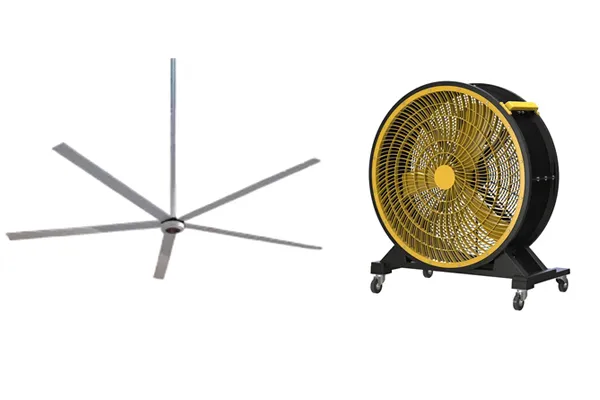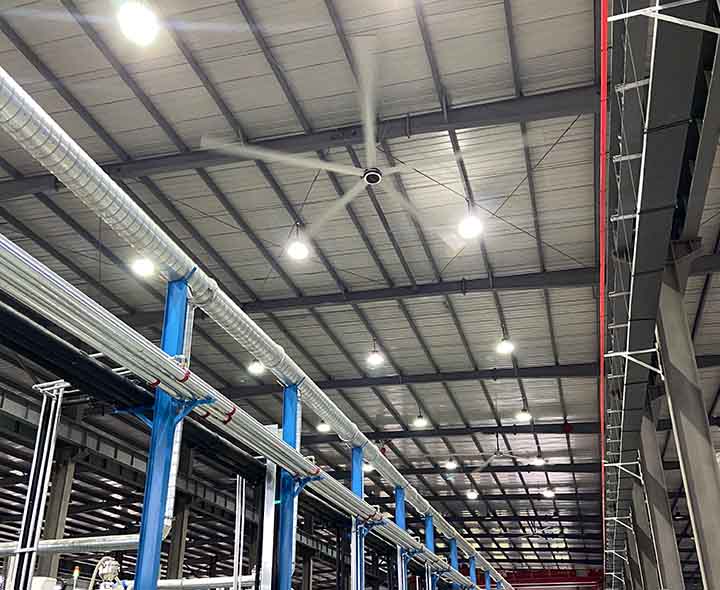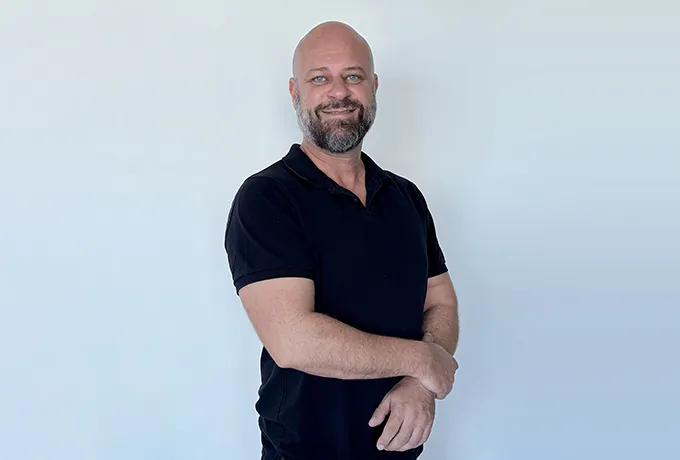Hot air stalls work. Staff slow down, machines strain, and bills rise. A well-chosen ventoinha de arrefecimento fixes this—quickly, safely, and affordably.
Cooling fans for factories are large ventilador de refrigeração industrial systems—often HVLS ventilador de teto solutions—that mix air, boost ventilação, and create a cooling effect across wide floor areas. By moving steady fluxo de ar, they cut heat stress, improve qualidade do ar, and lower HVAC runtime. In warehouses and plantas de fabricação, HVLS and other ventilador industrial types provide efficient arrefecimento industrial at low speed and baixo ruído, helping reduce energy use while keeping people and processes comfortable.

cooling fan industrial cooling fan for factory and warehouse
As an HVLS ventoinha de arrefecimento manufacturer supplying comercial e industrial spaces worldwide, we design, test, and install fans that move steady air across big footprints—factories, armazém aisles, sports halls, and gym floors—delivering reliable comfort and measurable savings.
Um ventilador de refrigeração industrial is built to move large air masses across broad spaces for efficient cooling and comfort. Unlike small desk units, these fans are engineered for ambientes industriais, where ceiling heights, rack layouts, and heat from industrial machinery complicate air patterns.
The most familiar type is the HVLS ventilador de teto (high-volume, low-speed). With diameters well above residential units, the fan delivers gentle, uniform fluxo de ar that “washes” the floor. People feel cooler through evaporativo effect on skin, while equipment gets steadier temperatures. In winter, the same fan provides destratification—mixing warm air down to reduce heat loss.
“Large-diameter ceiling fans (LDCF) are defined as ≥7 ft (2.1 m) and are used for mixing and destratification.”
HVLS (high-volume, low-speed) fans create a widespread, gentle breeze using huge blades at slow rpm—ideal for open floor areas. Alta velocidade units (think smaller, fast-spinning heads) focus on spot cooling along lines or stations.
When to choose HVLS
When to choose high-velocity floor or wall units
Studies and field guidance summarize the benefits succinctly: destratification can cut winter heating costs by ~25% and summer cooling by up to ~30% when properly applied in big spaces.

Industrial Floor Fan vs Industrial Ceiling Fan
A facility engenheiro cares less about rpm and more about the quantidades de ar over the floor. For comfort, you want steady feet-per-minute (fpm) at head height—not gusts. HVLS ventilador de teto systems are built to move huge amounts of air with minimal power, creating an even layer that keeps sweat evaporating and temperatures more uniform.
AMCA and DOE frameworks define ratings and test points for large-diameter ceiling fans, improving comparability across products.
Ventiladores axiais (propeller-type) push air straight through the fan ring. They’re common as ventiladores industriais e comerciais for spot cooling, wall exhaust, and make-up air. Ventiladores centrífugos develop pressure for ducted systems and filtration. Ventiladores direcionais (portable or pendant) aim air where people stand—good for line work or temporary heat pockets.
In hot, dry regions, resfriamento evaporativo can drop supply-air temperature dramatically. Pairing it with fans improves mixing and delivery across the floor. However, in humid climates the effect diminishes, and you must watch indoor RH to protect processes and packaging.
Sim. Grande diâmetro fãs comerciais running at slow rpm create smooth, laminar flow with baixo ruído—ideal around classrooms, centros esportivos, and assembly lines that demand calm acoustics. You still get the floor-level cooling effect without the whine of small, fast impellers.
Properly applied HVLS systems provide comfort with modest power draw and reduced HVAC runtime; several guides and trainings (ASHRAE/AMCA) document these benefits.
Use this 5-step approach to select the fã direito for your facility—and the right industrial cooling fan model for each zone.
| Fan type | Best spaces | Coverage style | Key advantages |
|---|---|---|---|
| HVLS ventilador de teto | Open bays, gyms, armazém | Broad “wash” | Setpoint relief, destratification |
| Ventiladores axiais | Walls, doors, lines | Focused jet | Simple, low static |
| Ventiladores centrífugos | Ducted capture/filters | Through ductwork | Pressure capability |
| Portable directional fans | Temporary hot spots | Movable | Flexible deployment |
Note: Always confirm clearances, sprinklers, and local code.
Well-applied ventoinha de arrefecimento strategies reduce compressor runtime and improve circulação de ar. Even when HVAC stays the same, mixed air lowers thermal management solutions risk (overheated PLC cabinets, uneven curing). Good ventilação—per ASHRAE 62.1—paired with mixing boosts air quality and comfort across shift patterns.
Manufacturing—assembly hall (illustrative):
A 9-m high bay with heat from presses suffers warm air pooling aloft. After installing four HVLS units, operators raised the cooling setpoint by 2–3°C and reported steadier comfort at the floor. (This mirrors ASHRAE/AMCA findings on destratification and setpoint relief in tall buildings.)
Sports center—multi-court gym (illustrative):
Spectators complained about stuffiness. Two large ventoinha de arrefecimento units now blanket the courts with gentle air. Noise stays low for coaching, and summer HVAC hours dropped. Results align with industry reports showing setpoint increases and ~20–30% seasonal savings when HVLS complements AC.

HVLS Fan in Manufacturing factiry
Smart controls let a ventoinha de arrefecimento track occupancy, temperature, and schedules. Add fan accessories like downrods, mounts, and guards to match structure and safety needs. In winter, pair fans with heating systems to recirculate ceiling heat, trimming fuel use while keeping operators comfortable under tall roofs.
Fans are robust for demanding industrial duty: sealed gearboxes, efficient drives, and solid hubs. Our os fãs são projetados para reliable cooling em industrial conditions while meeting code and sprinkler clearances. Integrations deliver fans to meet seu specific cooling e desempenho de resfriamento objectivos.
When you evaluate the range of fans, ask vendors for:
References, trainings, and rulemakings: AMCA LDCF basics and AHR presentations, DOE proposals for fan standards, and ASHRAE features on destratification in large buildings.
Are cooling fans enough without air conditioning?
Often, yes for shoulder seasons and dry climates. Fans increase evaporative comfort and mix hot/cool layers. In hot–humid regions, combine with AC or resfriamento evaporativo judiciously.
How big should my HVLS fan be?
Use height, obstructions, and target fpm to choose diameter and quantity. Your vendor’s selection software or an engenheiro can size accurately per zone.
Do large fans help in winter?
Yes—destratification mixes warm ceiling air to the floor, reducing heating energy (commonly cited up to ~25%).
Will fans interfere with sprinklers?
Code requires clearances and interlocks. Reputable manufacturers publish guidelines and accessories to maintain compliance.
What about standards and testing?
Ask for AMCA 230 data and DOE efficiency info; these frameworks improve apples-to-apples comparisons.
Can I see examples in real sites like warehouse or gyms?
Yes—our application pages and independent case studies show layouts, coverage, and savings.
Baseline HVAC runtime (no fans) | ██████████████████████████ 100
With HVLS fans (summer) | ████████████████ 70–80*
With HVLS fans (winter) | ███████████████ 70–75*
*Illustrative ranges; verify with your energy model and site data.
Guidance and examples in the industry show meaningful reductions when fans are integrated and controlled well. Always validate with your building’s specifics.
Porque fans manufacturing is our core business, we build a range of fans to fit comercial e industrial layouts—from HVLS to ac fans, dc fans, and clean-air exaustores. Nosso os ventiladores são projetados para grande indústria bays and various industrial footprints, and our fãs oferecem control options, safety certifications, and hardware to match your roof and utilities. If you’ve browsed “fans at industrial fans direct” for benchmarks, bring your notes—we’ll help you choose the melhor fã and deliver cooling solutions tailored para o seu necessidades de resfriamento com custom cooling where it’s needed most.
Fans also offers turnkey support: design, install, commission, and training—so your fan solution delivers efficient cooling day one.
This article reflects first-hand application experience from our factory team designing HVLS systems for plantas de fabricação, distribution armazém projects, gyms, and public halls around the world, paired with publicly available standards and studies cited above.If you manage a floor where people sweat and product tolerances tighten as temperatures rise, a properly selected ventoinha de arrefecimento is fast ROI—less strain on compressors, steadier work, and happier teams. Tell us your square footage and ceiling height; we’ll suggest the right cooling layout in one business day.

Olá, eu sou Michael Danielsson, CEO da Vindus Fans, com mais de 15 anos de experiência na indústria de engenharia e design. Estou aqui para compartilhar o que aprendi. Se você tiver alguma dúvida, sinta-se à vontade para entrar em contato comigo a qualquer momento. Vamos crescer juntos!